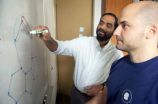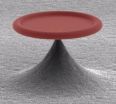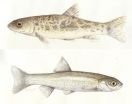(Press-News.org) PROVIDENCE, R.I. [Brown University] — The website of the Nobel Prize shows a cat resting in a graphene hammock. Although fictitious, the image captures the excitement around graphene, which, at one atom thick, is the among the thinnest and strongest materials ever produced.
A significant obstacle to realizing graphene's potential lies in creating a surface large enough to support a theoretical sleeping cat. For now, material scientists stitch individual graphene sheets together to create sheets that are large enough to investigate possible applications. Just as sewing patches of fabric together may create weaknesses where individual patches meet, defects can weaken the "grain boundaries" where graphene sheets are stitched together — at least that is what engineers had thought.
Now, engineers at Brown University and the University of Texas–Austin have discovered that the grain boundaries do not compromise the material's strength. The grain boundaries are so strong, in fact, that the sheets are nearly as strong as pure graphene. The trick, they write in a paper published in Science, lies in the angles at which the individual sheets are stitched together.
"When you have more defects, you expect the strength to be compromised," said Vivek Shenoy, professor of engineering and the paper's corresponding author, "but here it is just the opposite."
The finding may propel development of larger graphene sheets for use in electronics, optics and other industries.
Graphene is a two-dimensional surface composed of strongly bonded carbon atoms in a nearly error-free order. The basic unit of this lattice pattern consists of six carbon atoms joined together chemically. When a graphene sheet is joined with another graphene sheet, some of those six-carbon hexagons become seven-carbon bonds — heptagons. The spots where heptagons occur are called "critical bonds."
The critical bonds, located along the grain boundaries, had been considered the weak links in the material. But when Shenoy and Rassin Grantab, a fifth-year graduate student, analyzed how much strength is lost at the grain boundaries, they learned something different.
"It turns out that these grain boundaries can, in some cases, be as strong as pure graphene," Shenoy said.
The engineers then set out to learn why. Using atomistic calculations, they discovered that tilting the angle at which the sheets meet — the grain boundaries — influenced the material's overall strength. The optimal orientation producing the strongest sheets, they report, is 28.7 degrees for sheets with an armchair pattern and 21.7 degrees for sheets with a zigzag layout. These are called large-angle grain boundaries.
Large-angle grain boundaries are stronger because the bonds in the heptagons are closer in length to the bonds naturally found in graphene. That means in large-angle grain boundaries, the bonds in the heptagons are less strained, which helps explain why the material is nearly as strong as pure graphene despite the defects, Shenoy said.
"It's the way the defects are arranged," Shenoy said. "The grain boundary can accommodate the heptagons better. They're more relaxed."
INFORMATION:
Rodney Ruoff from the University of Texas–Austin's Department of Mechanical Engineering is a contributing author on the paper. The National Science Foundation and the Semiconductor Research Corporation's Nanoelectronics Research Initiative funded the research.
Graphene's strength lies in its defects
2010-11-12
ELSE PRESS RELEASES FROM THIS DATE:
New analysis explains formation of bulge on far side of moon
2010-11-12
SANTA CRUZ, CA--A bulge of elevated topography on the farside of the moon--known as the lunar farside highlands--has defied explanation for decades. But a new study led by researchers at the University of California, Santa Cruz, shows that the highlands may be the result of tidal forces acting early in the moon's history when its solid outer crust floated on an ocean of liquid rock.
Ian Garrick-Bethell, an assistant professor of Earth and planetary sciences at UC Santa Cruz, found that the shape of the moon's bulge can be described by a surprisingly simple mathematical ...
Contact among age groups key to understanding whooping cough spread and control
2010-11-12
ANN ARBOR, Mich.---Strategies for preventing the spread of whooping cough---on the rise in the United States and several other countries in recent years---should take into account how often people in different age groups interact, research at the University of Michigan suggests.
The findings appear in the Nov. 12 issue of the journal Science.
Thanks to widespread childhood vaccination, whooping cough (pertussis) once seemed to be under control. But the illness, which in infants causes violent, gasping coughing spells, has made a comeback in some developed countries ...
Fruit flies lead scientists to new human pain gene
2010-11-12
Boston, Mass. - While it has become clear in recent years that susceptibility to pain has a strong inherited component, very little is known about actual "pain genes" and how they work. In the November 12th issue of Cell, researchers at Children's Hospital Boston and their collaborators report on a novel human pain gene. People with minor variations in this gene showed clear differences in susceptibility to acute heat pain and chronic back pain. Corroborating mouse studies give some clues as to how the gene controls pain sensitivity. The gene was uncovered in a genome-wide ...
All-optical transistor
2010-11-12
Controlling and modulating the flow of light is essential in today's telecommunications-based society. Professor Tobias Kippenberg and his team in EPFL's Laboratory of Photonics and Quantum Measurements have discovered a novel way to couple light and vibrations. Using this discovery, they built a device in which a beam of light traveling through an optical microresonator could be controlled by a second, stronger light beam. The device thus acts like an optical transistor, in which one light beam influences the intensity of another.
Their optical microresonator has two ...
Having severe acne may increase suicide risk
2010-11-12
Individuals who suffer from severe acne are at an increased risk of attempting suicide, according to a paper published on bmj.com today.
The study also finds that an additional risk may be present during and up to one year after treatment with isotretinoin, a commonly prescribed drug for severe acne. However, the authors stress that this additional risk is most likely due to the acne itself, rather than the drug treatment.
Isotretinoin (commonly marketed as Roaccutane, Accutane, Amnesteem, Claravis, Clarus or Decutan) has been used to treat severe acne since the 1980s. ...
Thousands of turtles captured in Madagascar despite ban
2010-11-12
New research has revealed up to 16,000 endangered turtles are being caught each year by villagers in just one region of Madagascar, despite a government ban.
Researchers from the University of Exeter and Blue Ventures Conservation say the figure, thought to be a conservative estimate, is the first direct assessment of turtle exploitation on the island.
The study highlights the extent of small-scale fishing, traditionally very difficult to monitor, and could be vital in finding a way to sustainably manage turtle fishing in the region.
Dr Annette Broderick, from the ...
Study points to window of opportunity for successful autism therapy
2010-11-12
"The biggest surprise to me was that we could rescue the autistic phenotype [in the human cells] to something close to normal," said Alysson Muotri of the University of California San Diego.
The researchers made the discovery by first transforming adult cells taken from patients with Rett Syndrome into induced pluripotent stem cells (iPS cells) using an established cocktail. iPS cells look and act very much like embryonic stem cells.
Those stem cells were able to form functional neurons in cell culture. However, neurons derived from Rett Syndrome patients exhibited ...
A long history of pain: Study finds pain gene common to flies, mice and humans
2010-11-12
They show that one of those genes in particular has a long evolutionary history, as evidenced by the fact that it plays a role in pain sensing in flies, mice and humans. At least in mice, the newly described gene is also linked to a condition known in humans as synesthesia, in which one sensory experience triggers the perception of another sense.
"We found lots of new genes and pathways that have never been implicated in pain before," said Josef Penninger of the Institute of Molecular Biotechnology of the Austrian Academy of Sciences.
"From a helicopter view, this ...
23 percent of young people get into fights when they go out at night
2010-11-12
Night-time violence among young Spaniards is becoming ever more common, according to a research study carried out by the European Institute of Studies on Prevention. The study shows that 5.2% of young people carry weapons when they go out at night, 11.6% have been attacked or threatened, and 23% have got into a fight at some time.
"Reports about young people being attacked or injured in fights when they go out at night are becoming increasingly common", Amador Calafat, lead author of the study and a researcher at the European Institute of Studies on Prevention (IREFREA), ...
Invasive species -- the biggest threat to fish in the Mediterranean basin
2010-11-12
An international team led by the Forest Technology Centre of Catalonia has carried out the first large-scale study of the threats facing freshwater fish in the Mediterranean basin. Invasive species, along with over-exploitation of water resources, are the most important pressures, and those that expose fish to the greatest risk of extinction.
"The continental fish of the Mediterranean basin are one of the most threatened biological groups in the world", Miguel Clavero, lead author of the study and a researcher from the Landscape Ecology Group of the Forest Technology ...




